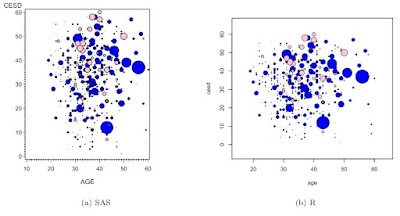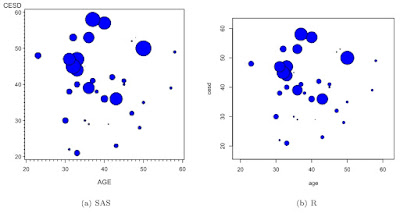We simulate both event times from a Weibull distribution with a scale parameter of 1 (this is equivalent to an exponential random variable). The event time has a Weibull shape parameter of 0.002 times a linear predictor, while the censoring time has a Weibull shape parameter of 0.004. A scale of 1 implies a constant (exponential) baseline hazard, but this can be modified by specifying other scale parameters for the Weibull random variables.
First we'll simulate the data, then we'll fit a Cox proportional hazards regression model (section 4.3.1) to see the results.
Simulation is relatively straightforward, and is helpful in concretizing the notation often used in discussion survival data. After setting some parameters, we generate some covariate values, then simply draw an event time and a censoring time. The minimum of these is "observed" and we record whether it was the event time or the censoring time.
SAS
data simcox;
beta1 = 2;
beta2 = -1;
lambdat = 0.002; *baseline hazard;
lambdac = 0.004; *censoring hazard;
do i = 1 to 10000;
x1 = normal(0);
x2 = normal(0);
linpred = exp(-beta1*x1 - beta2*x2);
t = rand("WEIBULL", 1, lambdaT * linpred);
* time of event;
c = rand("WEIBULL", 1, lambdaC);
* time of censoring;
time = min(t, c); * which came first?;
censored = (c lt t);
output;
end;
run;
The phreg procedure (section 4.3.1) will show us the effects of the censoring as well as the results of fitting the regression model. We use the ODS system to reduce the output.
ods select censoredsummary parameterestimates;
proc phreg data=simcox;
model time*censored(1) = x1 x2;
run;
The PHREG Procedure
Summary of the Number of Event and Censored Values
Percent
Total Event Censored Censored
10000 5971 4029 40.29
Analysis of Maximum Likelihood Estimates
Parameter Standard
Parameter DF Estimate Error Chi-Square Pr > ChiSq
x1 1 1.98628 0.02213 8059.0716 <.0001
x2 1 -1.01310 0.01583 4098.0277 <.0001
Analysis of Maximum Likelihood Estimates
Hazard
Parameter Ratio
x1 7.288
x2 0.363
R
n = 10000
beta1 = 2; beta2 = -1
lambdaT = .002 # baseline hazard
lambdaC = .004 # hazard of censoring
x1 = rnorm(n,0)
x2 = rnorm(n,0)
# true event time
T = rweibull(n, shape=1, scale=lambdaT*exp(-beta1*x1-beta2*x2))
C = rweibull(n, shape=1, scale=lambdaC) #censoring time
time = pmin(T,C) #observed time is min of censored and true
event = time==T # set to 1 if event is observed
Having generated the data, we assess the effects of censoring with the table() function (section 2.2.1) and load the survival() library to fit the Cox model.
> table(event)
event
FALSE TRUE
4083 5917
> library(survival)
> coxph(Surv(time, event)~ x1 + x2, method="breslow")
Call:
coxph(formula = Surv(time, event) ~ x1 + x2, method = "breslow")
coef exp(coef) se(coef) z p
x1 1.98 7.236 0.0222 89.2 0
x2 -1.02 0.359 0.0160 -64.2 0
Likelihood ratio test=11369 on 2 df, p=0 n= 10000
These parameters result in data where approximately 40% of the observations are censored. The parameter estimates are similar to the true parameter values.


